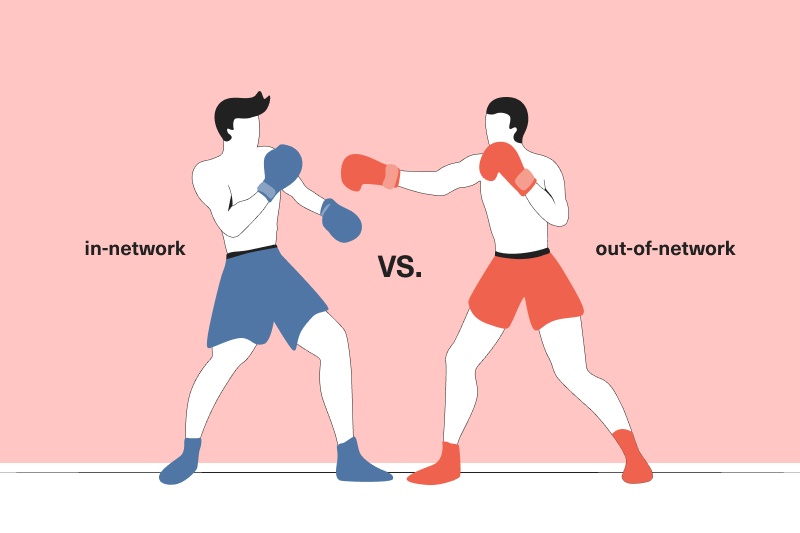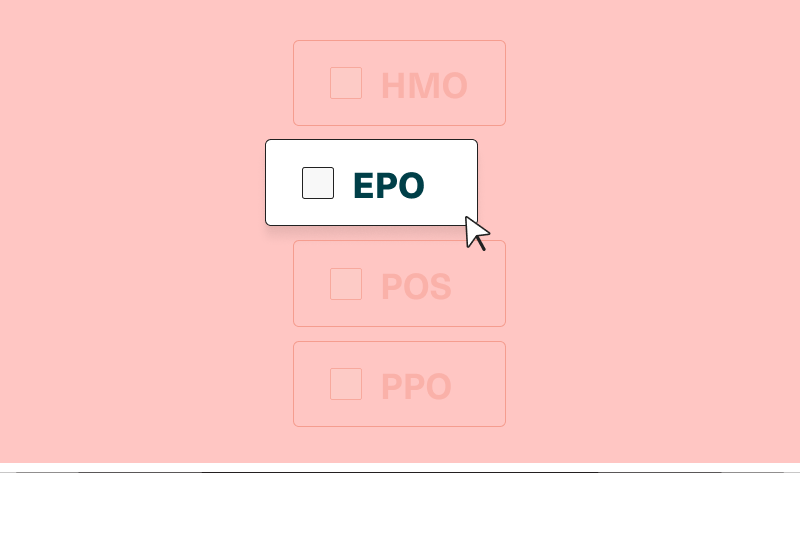Health insurance 101: In-network vs. out-of-network

Last updated on August 31, 2023
If you’re a small business owner or HR professional interested in learning about employee health insurance plans, it’s important to understand the ins and outs of provider networks … literally! This post discusses what in-network vs. out-of-network means and how to think about provider networks when shopping for group health insurance plans. We’ll also cover everything you need to know to explain these concepts to employees.
What is a provider network?
What is a provider network?A provider network is the group of medical providers, facilities, and suppliers a health insurer or health plan has contracted with to provide its plan members with healthcare at a negotiated price. Provider networks are sometimes called health insurance provider networks or health insurance networks.
Provider networks can include primary care doctors, specialty physicians, hospitals, surgery centers, urgent care clinics, labs, pharmacies, medical equipment companies, and more. These various healthcare entities agree to provide discounted services to plan members in exchange for the health plan sending a higher volume of customers their way.
Some health plans have extensive provider networks, while others’ networks are more narrow. As a health plan member looking to avoid high healthcare costs, you typically have to distinguish between in-network vs. out-of-network providers.
However, certain health plans like Sana use fair-value reimbursement to ensure members receive high-value care even when choosing out-of-network providers.
What does in-network mean?
What does in-network mean?In-network providers have a negotiated price for services set with your health plan, and your insurer will pay its responsibility according to the plan.
In-network providers have to bill your health plan directly, which means you will only owe your predetermined copay or deductible at the time of care. Your insurance plan will collect any additional coinsurance, the percentage of the bill you are responsible for paying, later.
Insurance plans frequently change provider networks to control costs and provide the best care for members. For instance, a plan might decide not to renew a contract with a particular specialist if they can negotiate better rates with other providers.
Insurance providers should have online search functions — such as a provider directory or a find-a-doctor tool — that make it easy and convenient for members to determine which doctors and facilities are in-network. It’s important to regularly check the network directory to avoid unexpected out-of-network fees if your provider leaves your health plan.
Benefits of using in-network providers
Members typically enjoy significant financial advantages by choosing in-network facilities and providers.
In-network providers agree to offer their services at lower rates set by your insurance plan. For instance, an in-network provider might only charge a $50 copayment for X-rays, while an out-of-network provider could charge $500 for the same service. Over time, these price differences can add up to tens of thousands of dollars in savings, especially if members need frequent or expensive procedures.
Additionally, any money you spend at an in-network provider gets counted toward your health plan’s annual deductible and out-of-pocket maximum. For instance, if you owe a copay or coinsurance for in-network services, these expenses will be applied to your deductible.
By contrast, if you go to an out-of-network provider, any costs you pay may not count toward your deductible, depending on your health plan and insurance provider. Sana counts everything toward the deductible, including out-of-network costs, but this isn’t the case for all insurance companies.
Administrative processes are another factor to consider when comparing in-network vs. out-of-network insurance. Health plans have already added in-network providers to their systems so they can process their claims more accurately and efficiently. The provider is reimbursed faster, and you receive your bill sooner.
In addition, employers can predict their annual expenses more accurately when members stay in-network. They also spend less time settling billing disputes with providers who haven’t agreed to the plan’s contracted rates.
What does out-of-network mean?
What does out-of-network mean?Out-of-network providers do not have a negotiated price for services set with your health plan, and they may or may not be paid for by your plan.
Out-of-network providers can require you to pay your entire bill upfront instead of submitting an insurance claim for you — in this case, you would be responsible for submitting a claim to your insurer for reimbursement. They can also balance-bill you, meaning that they can ask you to pay for any portion of the bill that your insurance plan won’t cover.
By looking up in-network providers ahead of time in the network directory, you can avoid receiving unexpectedly high bills for your care.
Potential drawbacks of using out-of-network providers
Employees may choose to visit out-of-network providers for many reasons, including personal preference and travel outside the plan’s geographic region. However, using these providers has several disadvantages, including:
- Higher Costs: Businesses that provide insurance to their employees may face higher costs if employees frequently choose to go out of network. This can lead to increased premiums for the company and its employees in the long run.
- Administrative Burden: Processing claims for out-of-network care can be more complex and time-consuming for insurance providers. This administrative burden can increase ops costs.
- Lower Employee Satisfaction: If employees face higher out-of-pocket costs and balance billing when using out-of-network providers, they might become dissatisfied with their insurance coverage and their employer’s benefits package.
How do health plan types relate to provider networks?
How do health plan types relate to provider networks?Some plan types tend to have larger provider networks than others, and different plan types approach the coverage of out-of-network care differently. Below are overviews of the most common plan designs and their policies regarding out-of-network care coverage.
HMO
HMOs, or health maintenance organizations, have narrow provider networks, and they don’t cover out-of-network care except in cases of emergency. This plan type requires referrals from an in-network primary care physician (PCP) for specialty care from in-network providers. Because of these limitations, HMOs tend to be the least expensive plan type.
EPO
EPOs, or exclusive provider organizations, have larger provider networks than HMOs, so they are slightly less limiting. Most plans don’t require you to have a PCP, and you can typically visit any in-network specialist without a referral. However, you may need to request prior authorization from your health plan for specific procedures and treatments.
Also, like HMOs, EPOs don’t cover out-of-network care unless it’s an emergency. Referrals for specialty care are required in some cases.
PPO
PPOs, or preferred provider organizations, allow members to seek out-of-network care and don’t require referrals from a PCP for specialist visits. PPOs tend to cost more because they are the least restrictive plan type.
PPO in-network vs. out-of-network costs can vary dramatically. Members are commonly required to pay considerably higher coinsurances and copays for out-of-network providers than in-network providers. Plus, maximum allowable out-of-pocket costs are usually higher for out-of-network care.
POS
POS plans, or point-of-service plans, combine aspects of both HMO and PPO plans. They require referrals from an in-network primary care physician but allow out-of-network care for an additional cost. As a result, they’re often preferred by people who travel frequently. These plans are often less expensive than PPOs and don’t charge deductibles for in-network providers.
What to consider when choosing plan types for your employees
What to consider when choosing plan types for your employeesIt’s important to understand the differences between plan types if you are shopping for group health insurance for your employees. Plan costs tend to increase as plan flexibility increases, so you’ll need to do your research and strike a balance between costs and benefits.
And don’t forget to read the fine print — some insurance companies offer plan designs with unique restrictions. For example, UnitedHealthcare sells some plans with provider networks with various tiers, and members have to pay a higher copay (and sometimes a higher coinsurance percentage) when they don’t use Tier 1 providers. And some Blue Cross Blue Shield plans, for instance, give members a choice between three different networks upon enrollment.
The ideal plans allow employees to access excellent healthcare without straining your business’s budget. These considerations can help you find the right plan.
Fully-funded insurance vs. self-funded insurance
Fully-funded insurance vs. self-funded insuranceMany employers choose traditional, fully-funded insurance plans. These plans require businesses to pay a fixed annual premium based on the number of covered members. In exchange, the insurance company handles all administrative responsibilities and pays claims for members based on the policy’s terms.
Fully-funded insurance has drawbacks, including limited cost control, lack of customization, and reduced employer control over benefits, all of which can result in unpredictable costs, less flexibility, and potentially dissatisfied employees.
Self-funded insurance transfers the financial risk to the employer. The business owner collects premiums directly from the employees and pays for their claims. Self-funded insurance can give employers more freedom to customize their plans, and the claims you receive may cost less than annual premiums. However, self-funded insurance often requires employers to handle or outsource claims processing and other administrative tasks to a third-party administrator (TPA).
Network size
The size of the network affects the health plan’s cost and flexibility. Narrow networks give members fewer options, so they may not have access to preferred providers and treatments. However, providers may agree to charge significantly lower rates in exchange for a higher concentration of patients.
Broad networks provide more flexibility and ensure that members have access to a variety of hospitals and specialists. However, this freedom often comes at the cost of higher premiums because providers have less incentive to negotiate discounted rates.
Provider accessibility
Employees who live close to in-network providers can access healthcare more conveniently and quickly but may have to travel long distances for appointments if their health plan doesn’t include local providers. As a result, they could miss out on vital care or need to take more time off work to receive treatment.
Geographic region
Health plans often restrict coverage and provider networks to specific locations. Ensure that your chosen plan covers your employee base in your region.
Strategies to maximize in-network benefits and manage out-of-network situations
StrategiesHR professionals play a pivotal role in educating employees about their business’s health plan. These tips can encourage members to take advantage of in-network providers and make it easier to navigate out-of-network expenses.
Related: Small but mighty: How to thrive as an HR department of 1
Emphasize the value of in-network providers
Ensure that employees fully understand the cost disparities between in-network and out-of-network services. Members may find it helpful to receive pamphlets and other educational materials that use real-world scenarios to highlight how much they can save by choosing in-network providers.
Connect employees with resources
Insurance companies often offer free resources to help members understand their health plans. For instance, Sana’s support team is available to answer questions from members through chat or email, and our Health Center has many articles about insurance benefits for members and employers. In addition, many health plans have online directories that list in-network providers.
Negotiate out-of-network expenses
Covered members may incur out-of-network charges if they mistakenly choose an excluded provider or need to receive emergency care. You could assist employees by asking the insurance company to reimburse some or all of their expenses. You may also attempt to negotiate a discounted rate with the provider.
How Sana helps you manage in-network vs. out-of-network
How Sana helps you manage in-network vs. out-of-networkHealth plans with restrictive networks and high out-of-network fees can leave business owners and employees feeling disgruntled and stressed. Fortunately, you don’t have to settle for an expensive or inadequate plan.
Sana Benefits plans allow members to access top-notch care at a price small business owners love. Our growing network includes over 1.7 million providers, including our ecosystem of unique $0 Care Partners, so members have many options. Members can easily discover nearby primary care providers and specialists in our network using our convenient Find Care tool.
Additionally, our PPO Plus plans ensure that out-of-network providers receive fair reimbursement rates for all services without passing the cost on to members. That means employees can see any provider they want without paying out-of-network fees or waiting for a referral.
Contact us today for a free quote and learn more about how Sana Benefits can provide maximum cost savings and flexibility.
FAQs
Some health plans cover all out-of-network expenses incurred in emergencies and a fixed percentage of nonemergency charges. This extra coverage reduces the financial burden on members and increases access to providers. However, out-of-network coverage can also lead to higher costs for employers.
Providers agree to charge lower rates when they join an insurance plan’s network, allowing businesses and members to save money. Also, insurance companies typically require providers to meet high performance standards to renew their contracts, ensuring that members receive excellent care.
HMO and POS plans typically require members to choose a PCP before they enroll. By contrast, PPO and EPO plans often allow patients to choose their providers and visit specialists without referrals.






